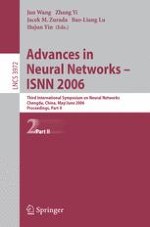This book and its sister volumes constitute the Proceedings of the Third International Symposium on Neural Networks (ISNN 2006) held in Chengdu in southwestern China during May 28–31, 2006. After a successful ISNN 2004 in Dalian and ISNN 2005 in Chongqing, ISNN became a well-established series of conferences on neural computation in the region with growing popularity and improving quality. ISNN 2006 received 2472 submissions from authors in 43 countries and regions (mainland China, Hong Kong, Macao, Taiwan, South Korea, Japan, Singapore, Thailand, Malaysia, India, Pakistan, Iran, Qatar, Turkey, Greece, Romania, Lithuania, Slovakia, Poland, Finland, Norway, Sweden, Demark, Germany, France, Spain, Portugal, Belgium, Netherlands, UK, Ireland, Canada, USA, Mexico, Cuba, Venezuela, Brazil, Chile, Australia, New Zealand, South Africa, Nigeria, and Tunisia) across six continents (Asia, Europe, North America, South America, Africa, and Oceania). Based on rigorous reviews, 616 high-quality papers were selected for publication in the proceedings with the acceptance rate being less than 25%. The papers are organized in 27 cohesive sections covering all major topics of neural network research and development. In addition to the numerous contributed papers, ten distinguished scholars gave plenary speeches (Robert J. Marks II, Erkki Oja, Marios M. Polycarpou, Donald C. Wunsch II, Zongben Xu, and Bo Zhang) and tutorials (Walter J. Freeman, Derong Liu, Paul J. Werbos, and Jacek M. Zurada).
